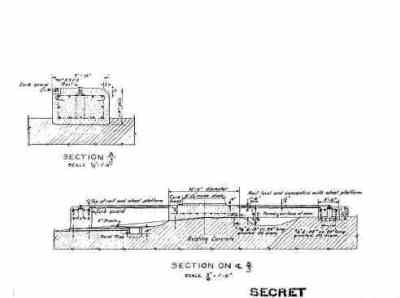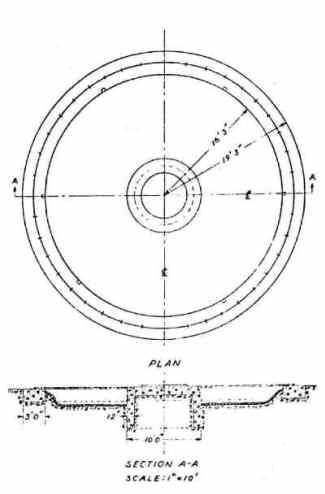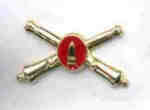 |
U. S. Army Coastal Artillery Battalion in Aruba & 32 Fighter Squadron |
 |
On February 13, 1942 American troops of the 498th Coastal Artillery Battalion arrived on Aruba and replaced the Cameron Highlanders who had been defending the island since September 3, 1940. The Americans took up residence in the camp at Saveneta and there they remained until the end of the war. The troop transport that carried the Americans to the island carried the Cameron Highlanders off the island for their trip back to Britain.
In addition to the troop transport that brought the men, an American military supply ship, the Henry Gibbons had also come to Aruba with equipment, supplies and 3,000 tons of ammunitions for the American troops. The troop transport had left with the Scottish troops but the supply ship was still in San Nicholas harbor on the night of the U Boat attack.
What remains of the foundations for the four 155 mm guns that were located on top of Colorado Point. Photo taken in 2005 by Steve Fremgen.
According to Mr. William Gaines of the Coast Defense Study Group, Two 90mm AMTB guns and two 40mm AA were also at this location. These 90mm and 40mm guns were probably not placed on permanent foundations.
PHOTO BY STEVE FREMGEN IN 2005
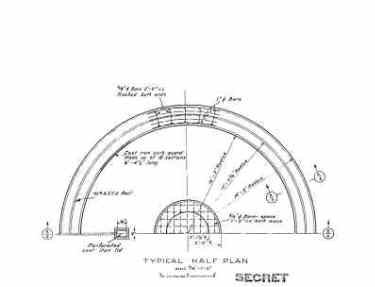
The Panama mount for the 155-mm mobile M1917M1 & M1918M1 GPF gun was developed in Panama during the late 1920s as a 180 degree mount rather than the 360 degree mount that was developed later in the 1930s and employed widely in WW II. I have attached some drawings of the Panama mount."
CLICK ON DRAWING TO SEE LARGER COPY.
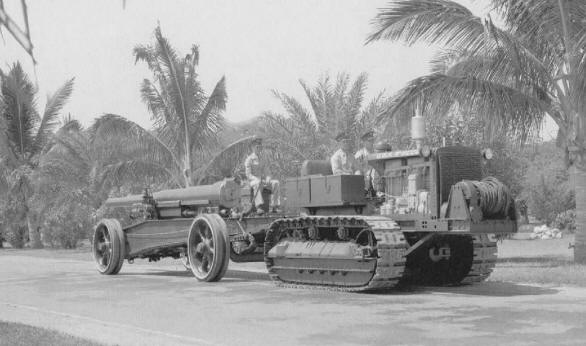
Photograph of 155-mm guns of the type used on Aruba. This one is on a carriage the ones in Aruba were mounted on the 360 degree. Panama mount foundations shown above.
Photo supplied by Mr. William Gaines
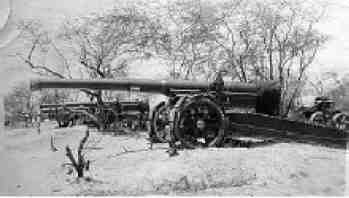
Another typical photograph of the 155mm gun used in Aruba.
This photo was also supplied by Mr. William Gaines
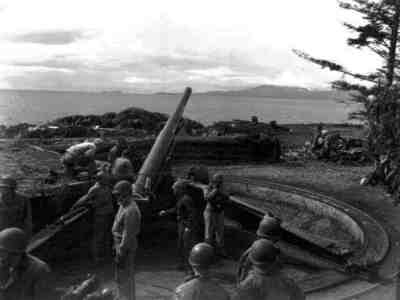
The 155mm gun mounted on the 360 degree Panama mounts as were used in Aruba at Colorado Point, however, this photograph is not taken in Aruba.
Photo used with permission from Mr. Joseph B. Stevens.
Photo credit to Austin Masterson
&
Another view of the 155 mm gun 360 degree Panama mount foundations. These photographs were taken by Steve Fremgen in 2005.
Yet another close-up of the 155 mm gun foundations. The U. S. Army 498th Coastal Artillery Battalion did a good job on the instillation as these photographs were taken in 2005 by Steve Fremgen and the foundation were installed in 1942.
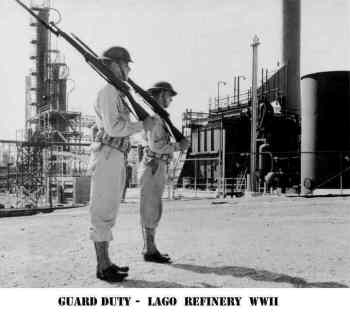
In addition to manning the guns at Colorado Point, the two 37mm AMTB guns at Camp Savaneta and numerous AA machine-guns around Dakota Field, now know as Queen Beatrix International Airport, the American troops also stood Guard Duty at the refineries. In this photo you see two American troops standing guard at the lago refinery. Photo supplied by Stan Norcom.
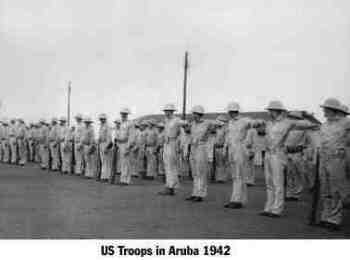
American troops line up for inspection at Camp Savaneta in 1942. Photo supplied by Stan Norcom.
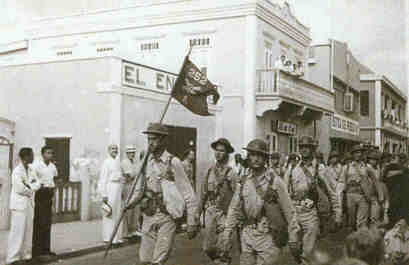
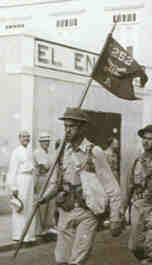
This is a photo from Ken Brown's scrapbook showing the American Troops on parade in Oranjstead.

Another photo from Ken Brown's scrapbook of the American Troops at their barracks in Savaneta.
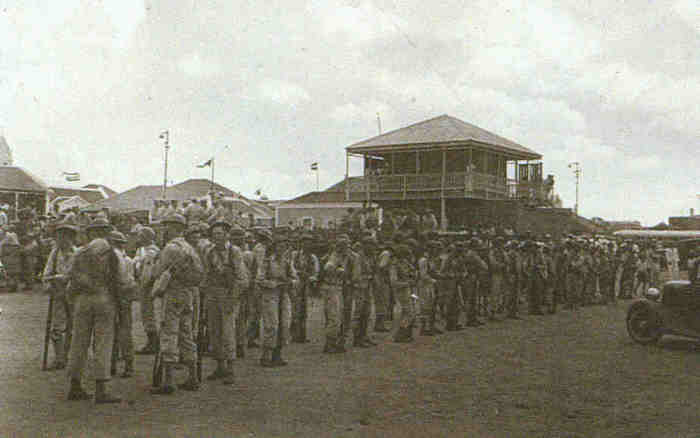
American Troops in Aruba, another photo from the Ken Brown Scrapbook.
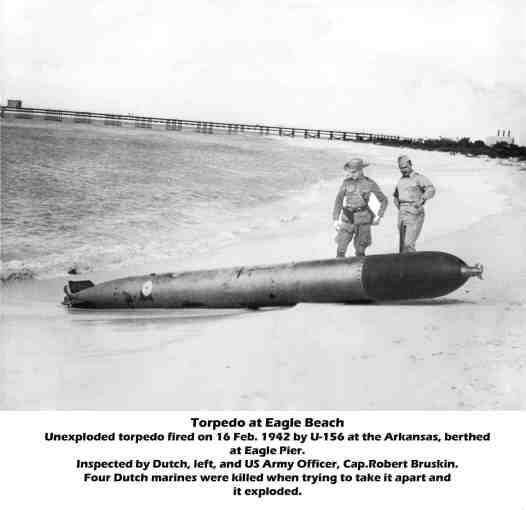
One of U-Boat 156's torpedo that missed its target, the tanker Arkansas berthed at the Eagle Pier and ran up on the Eagle Beach.
Unfortunately, the torpedo still managed to do damage when it exploded and killed the four Dutch Marines who were attempting to disarm it.
When the American troops arrived in Aruba in February of 1943 the families in Lago took individual solders under there wing and opened their homes to them.
In the case of the Jensen family I remember Bill Cann, pictured below at the T-Dock house with my mother and an unidentified other person. Bill came to parties, and we had him on the weekends and for dinner all the time he was stationed in Aruba.
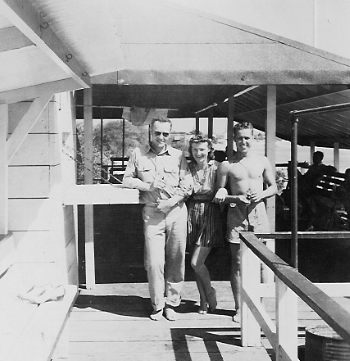
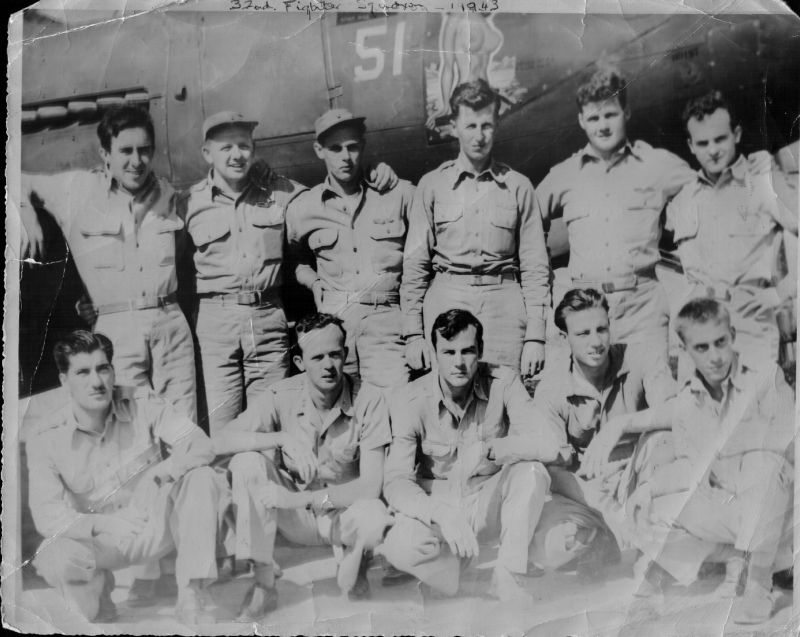
front row L to R ?, Capt Ramey, Capt, Ramsey,?,?
The squadron left Aruba 2nd January,1944 and assigned to various bases in the US, the ended up in Europe. Hanlon was shot down in Europe and killed in June 1944.
Dear Ted,
I am not writing a book on the 32nd as such, but rather on the
anti-submarine (air) war around the Neth. West Indies, which involves,
of course, the 32nd, but also B-18, B-24 squadrons and Naval Air units.
Anyway, the identification of the pilots on the picture you emailed is
as follows (per the explanation given to me by one of the 32nd pilots,
Don Baker):
Top row, left to right:
2Lt Edward M. Beaver
2Lt. Arthur E. Qualtney (killed in a P-38 in Panama) 2Lt. James J.
Epscamp 2Lt Gerard F. Cavanaugh - transferred to ETO, 95th Sqn P-38's.
2Lt Francis P. Hanlon - transferred to ETO, 95th Sqn P-38's, kia June 10
(or 16), 1944 2Lt. Robert B. Koster - killed in mid-air collision over
France Field, Panama botton row, L to R 2Lt Louis Grillo - xferred to
P-38's out of 32nd, ret'd as colonel Capt Virgil Roan, deputy CO at
Aruba Capt. Charles E. Ramsey, CO at Aruba, ret'd as colonel 2Lt Robert
B. Schick 2Lt Edward Slaughter - ret'd as major.
I believe that you got most of them correct. Actually, this is the Aruba
detachment - of course the main base of the 32nd was at Hato Field,
Curaçao. The pin-up on the nose of the P-39 is of course the famous
"Mona". The airplane is Capt. Ramsey's - he had Mona painted on the
fuselage panel by the original artist in Panama and kept switching the
panel as he changed P-39's.
The 32nd actually went to Panama in 1944 and stayed there until war's
end, but many of the pilots transferred to squadrons in Europe. The 32nd
functioned largely as an operational training unit during the final
period in Aruba and while in Panama, taking in many freshly trained
pilots for a while to get them accustomed in fighter ops before they
went overseas.
It is a strange coincidence that you mailed me the subject picture,
because when I went to check on the names in my collection, I found that
my own 8 x 10 original photograph is missing. I had loaned my binder
with 32nd pictures to someone a few months ago, and I only now find that
my print is "missing in action". Would it be possible that you let me
have a higher resolution scan of the photo (preferably 300-400 dpi) to
replace my lost one?
Regards,
Jerry Casius
